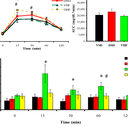Paraneoplastic neurological disorders in children with benign ovarian tumors.
Từ khóa
trừu tượng
OBJECTIVE
Paraneoplastic neurological diseases (PND) are rare, but potentially treatable disorders. Paraneoplastic encephalitis is rapidly emerging as an important but likely under-recognized condition in children. The aim of this study was to assess the prevalence and spectrum of PND in children with benign ovary tumor and the long-term outcome.
METHODS
We retrospectively reviewed the charts of all female patients below 18years of age diagnosed with a benign ovarian tumor proven by pathology between January 1993 and December 2010. All the clinical symptoms developed within 5years of tumor diagnosis and the related investigations were recorded.
RESULTS
There were total 133 children and adolescents with benign ovarian tumors, mostly mature teratoma. Six patients (4.5%) had neuropsychiatric manifestations and all but one were beyond age 10years. The most common neuropsychiatric presentations were depression or low mood (84%), headache (50%), mutism (50%), hypoventilation (50%), seizures (30%), hallucination (30%), vomiting and hypersalivation (30%). Three patients (2.2%) had serious PND including acute disseminated encephalomyelitis in 1 and anti-N-methyl-d-aspartate receptor (NMDAR) encephalitis in 2. Although all of three improved after tumor removal, one without immunotherapy had neurological sequelae and prolonged ICU stay.
CONCLUSIONS
The prevalence of PND in benign ovary tumor is not so uncommon in children. It is important to survey ovary tumors in female adolescents with subacute presentation of multiple-level involvement of neuraxis where no clear alternate diagnosis is possible. Treatment of serious PND associated with ovary tumors should include immunotherapy in addition to tumor removal.


